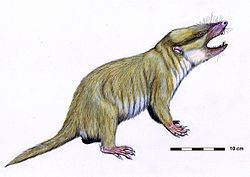Suborder Cynodontia Scientific name Mammaliaformes | Clade Mammaliamorpha Phylum Chordata | |
 | ||
Clade MammaliaformesRowe, 1988 Lower classifications Mammal, Opossum, Bear, Deer, Sloth | ||
Mammaliaformes ("mammal-shaped") is a clade that contains the crown group mammals and their closest extinct relatives; the group radiated from earlier probainognathian cynodonts. It is defined as the clade originating from the most recent common ancestor of Morganucodonta and the crown group mammals; the latter is the clade originating with the most recent common ancestor of extant Monotremata, Marsupialia, and Placentalia. Besides Morganucodonta and the crown group mammals, Mammaliaformes includes Docodonta and Hadrocodium as well as the Triassic Tikitherium, the earliest known member of the group.
Contents
Mammaliaformes is a term of phylogenetic nomenclature. In contrast, the assignment of organisms to Mammalia has traditionally been founded on traits and, on this basis, Mammalia is slightly more inclusive than Mammaliaformes. In particular, trait-based taxonomy generally includes Adelobasileus and Sinoconodon in Mammalia, though they fall outside the Mammaliaformes definition. These genera are included in the broader clade Mammaliamorpha, defined phylogenetically as the clade originating with the last common ancestor of Tritylodontidae and the crown group mammals. This wider group includes some families that trait-based taxonomy does not include in Mammalia, in particular Tritylodontidae and Brasilodontidae.
Animals in the Mammaliaformes clade are often called mammaliaforms, without the e. Sometimes, the spelling mammaliforms is used. The origin of true mammals (Mammalia) extends back to the Jurassic, with extensive findings in the Late Jurassic outcrops of Portugal and China.
Mammaliaformes in life
Early mammaliaforms were generally shrew-like in appearance and size, and most of their distinguishing characteristics were internal. In particular, the structure of the mammaliaform (and mammal) jaw and the arrangement of teeth are nearly unique. Instead of having many teeth that are frequently replaced, mammals have one set of baby teeth and later one set of adult teeth which fit together precisely. This is thought to aid in the grinding of food to make it quicker to digest. Warm-blooded animals require more calories than those that are cold-blooded, so speeding up the pace of digestion is a necessity. The drawback to the fixed dentition is that worn teeth cannot be replaced, as was possible for the reptilian ancestors of mammaliaforms. To compensate, mammals developed prismatic enamel, characterized by crystallite discontinuities that helped spread out the force of the bite.
Lactation, along with other characteristically mammalian features, is also thought to characterize the Mammaliaformes, but these traits are difficult to study in the fossil record. While the early mammaliaforms likely had some form of lactation, their mammary glands probably were not associated with distinct mammae with nipples but rather were distributed in patches on the belly side with the young licking milk from the fur like newly hatched monotremes today. The more primitive near-mammaliform Sinoconodon had teeth even from hatching and a poorly ossified jaw as young, indicating it did not suckle, while its close relative Morganucodon likely did. Prior to hatching, the milk glands would provide moisture to the leathery eggs, a situation still found in monotremes.
The early mammaliaforms did have a harderian gland, in modern mammals used for cleaning the fur, indicating that they, contrary to their Cynodont ancestors, had a furry covering. An insulative covering is necessary to keep a homeothermic animal warm if it is very small, less than 5 cm (1.97 in) long; The 3.2 cm (1.35 in) Hadrocodium must have had fur, therefore, but the 10 cm (3.94 in) Morganucodon might not have needed it. The docodont Castorocauda, further removed from crown group mammals than Hadrocodium, had two layers of fur, guard hairs and underfur, as do mammals today.
It is possible that early mammaliaforms had vibrissae; Tritheledontidae, a group of Cynodonts, probably had whiskers. A common ancestor of all therian mammals did so. Indeed, some humans even still develop vestigial vibrissal muscles in the upper lip. Thus, it is possible that the development of the whisker sensory system played an important role in mammalian development, more generally.
Like monotremes today, the legs of early mammaliaforms were somewhat sprawling, giving a rather "reptilian" type of gait. However, there was a general tendency to have more erect forelimbs, forms like eutriconodonts even having a fundamentally modern forelimb anatomy while the hindlimbs remained "primitive"; this tendency is in some effect still seen in modern therian mammals, which often have more sprawling hindlimbs. In some forms, the hind feet likely bore a spur similar to those found in the platypus and echidnas. Such a spur would have been connected to a venom gland for protection or mating competition.
Hadrocodium lacks the multiple bones in its lower jaw seen in reptiles. These are still retained, however, in earlier mammaliaforms.
With the possible exception Megazostrodon and Erythrotherium (as well as placental mammals), all mammaliforms possess epipubic bones, a possibly synapomorphy with tritylodontids, which also have them. These pelvic bones strengthen the torso and support abdominal and hindlimb musculature. They, however, prevent the expansion of the abdomen, and so force species that possess them to either give birth to larval young (as in modern marsupials), or produce minuscule eggs that hatch into larval young (as in modern monotremes). Most mammaliforms, therefore, probably had the same constraints, and some species could have bore pouches.
Phylogeny
Cladogram based on Rougier et al. (1996) with Tikitherium included following Luo and Martin (2007).
